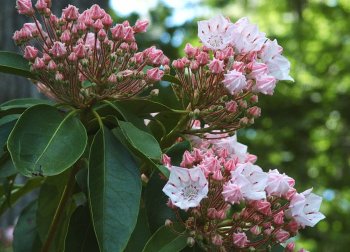- By Daniel Segal, The Plantsmen Nursery, Lansing
- Around Town
 Print
Print  Dan SegalTwo of the earliest images I can recall are the silver foil on Hershey's Kisses and the puffy geometry of the Kalmia latifolia flower. Considering this is a garden column, it's the latter we'll explore here (and I'll resolve the subliminal chocolate craving later).
Dan SegalTwo of the earliest images I can recall are the silver foil on Hershey's Kisses and the puffy geometry of the Kalmia latifolia flower. Considering this is a garden column, it's the latter we'll explore here (and I'll resolve the subliminal chocolate craving later).I have asked many friends and some customers what's the earliest botanical memory they can muster. What amazes me most is how many people have very early flower and plant memories. A friend told me recently that as a young boy, he decided for the first time that plants were cool when he discovered a colony of Jack-in-the-Pulpit on his grandfather's property in Pennsylvania. Another friend recalled dim memories of walks on trails with his grandmother, who was an herbalist and showed him wild plants that could be used for all kinds of things, from tea to food to medicine. A nursery woman who grew up near Philadelphia remembered painting her face with pokeweed fruits. With any luck, my kids will remember touching the touch-me-not capsules of Impatiens capensis, and the magic of spring-loaded seed dispersal.

Kalmia latifolia
I don't remember much from that age, but I do remember the Kalmia flowers and the white pine cones on the ground, frosted with white pitch. Now that my daughter is 3, when I see her staring at something intently in the garden, I can imagine some of those images being stamped into her brain for life. It's tempting to try and influence which things get stamped and seared into the brain, but adult perspective tells you two things at least: don't force it, and you can't tell what she'll remember anyway.

Jewel weed
Another early plant memory comes a little later, about age 5. We had just moved into a new house and I spent most of my summer days exploring the woods and ponds that marked the edge of our property. At one point, the main pond pinched down to a stream and then opened up into another larger pond. At the narrows was an old wooden bridge that had become overgrown with vegetation and was now not quite a bridge but a heap of railings, boards and posts.
As kids we dared each other to cross, or to get as far as you could before turning back. At the base of one of the bridge posts was the decaying skeleton of an old crow, still with some black feathers. The skeleton laid in the heart of a patch of skunk cabbage. So the smell of decaying bird carcass and musky skunk cabbage leaves became intertwined for me as a kid. As did the savage naturalness of the giant leaves, swampy ground, and the bones and feathers. It was a macabre scene, recalling something from Edgar Allen Poe or Edward Gorey. My memory is that my jaw always dropped when I went to visit the skunk cabbage patch with the bird bones. I loved it and feared it and didn't quite understand it.

Within a year or two from now, I hope to publish a book elaborating on this theme of early childhood plant memories. I am always interested in hearing those of other people, anyone who has any recollection at all of a plant from those early years of consciousness. This email address is being protected from spambots. You need JavaScript enabled to view it. if you will, say hello, and let me know what you remember.
----
v2i30



